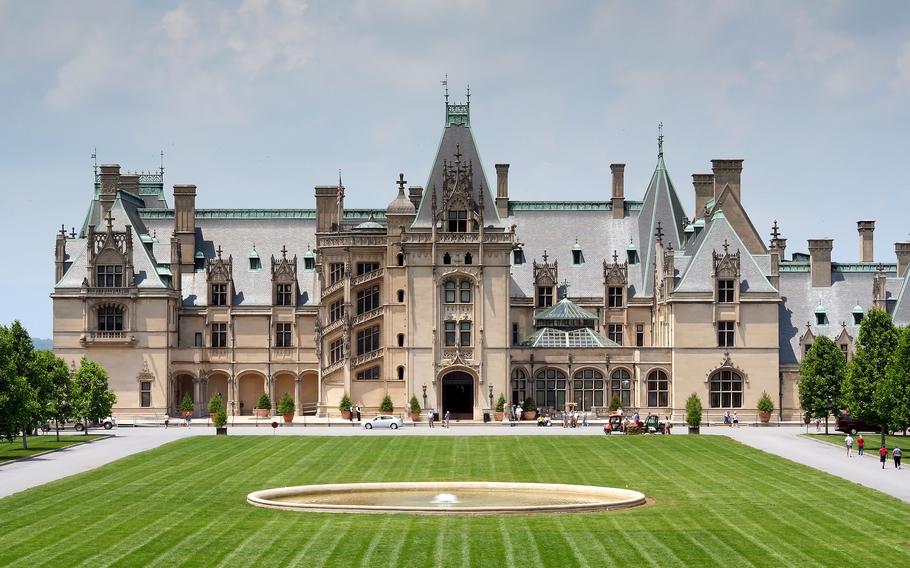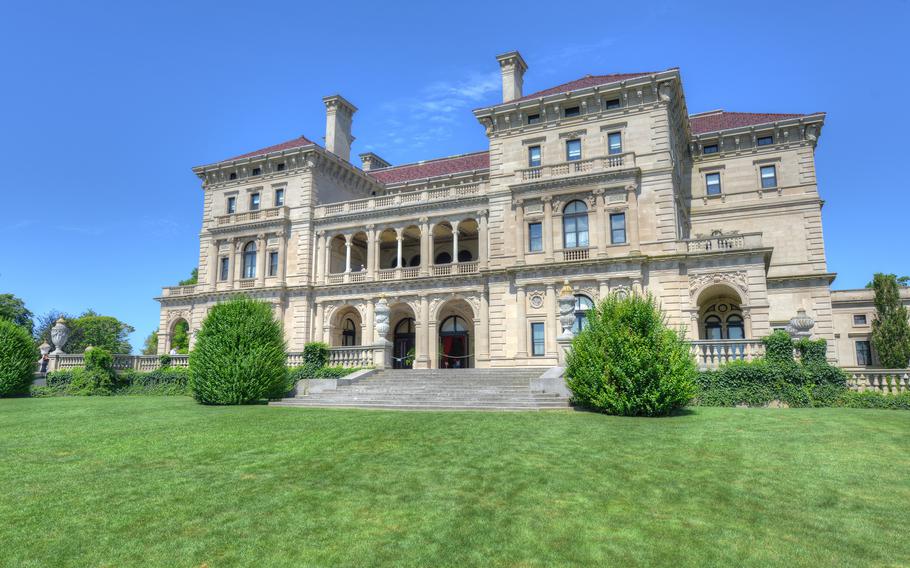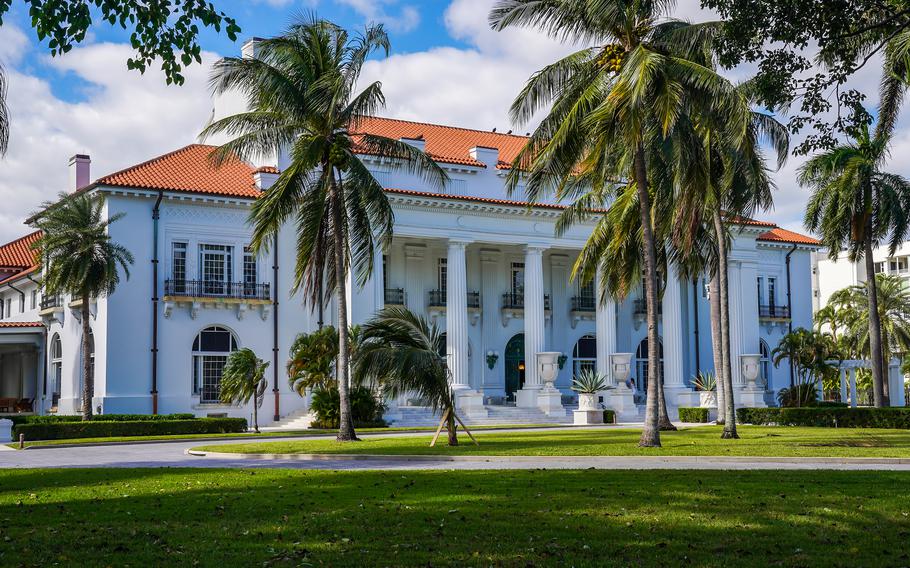
The French-Renaissance–château–style Biltmore Estate in Asheville, N.C. was built from 1889-1895 and consists of 250 rooms, including 35 bedrooms, 43 bathrooms, 65 fireplaces, an indoor swimming pool and a bowling alley. Technically advanced for its era, the estate was powered by Edison light bulbs and equipped with a fire alarm system, elevators, telephone, indoor plumbing, heating and electricity. (Dreamstime/TNS)
Mansions are fascinating, oozing with extravagant opulence or dripping with Southern charm and magnificent splendor, like the plantation homes in the South.
It’s fascinating to walk inside these stately residences and wonder about the secrets they hold. And of course, it’s delightful to stroll the lush gardens that surround many of these glorious structures, filled with colorful roses, fragrant wisteria and the wafting scents of magnolia blossoms.
Time travel may not be possible, but we can experience the next best thing by touring these living museums that preserve history by keeping the era in which they were built alive.
Here are some of the most impressive places to visit:

The Breakers in Newport, R.I., is a grand 70-room Italian-Renaissance-style mansion built between 1893 and 1895 for Cornelius Vanderbilt II, heir to America’s fortune in railroads. (Dreamstime/TNS)
The Breakers
There is certainly no shortage of Gilded Age mansions in Newport, R.I., but The Breakers is the crown jewel of them all.
This grand 70-room Italian-Renaissance-style mansion was built between 1893 and 1895 for Cornelius Vanderbilt II, heir to America’s fortune in railroads. The stunning chateau occupies 14 acres overlooking Easton Bay and is marked by ornate iron gates and a limestone wall, offering breathtaking ocean views. Though the construction cost was over $7 billion in the 1890s, the mansion is valued at well over $150 million today.
Rosecliff
If visitors have time to take in more than one Newport mansion, Rosecliff should be next on the list. The property is named for the rose gardens planted along Newport’s stunning Cliff Walk. The French Baroque Revival “summer cottage” was inspired by the Grand Trianon at Versailles with a distinctive H-shaped layout, white terracotta façade and paired Ionic pilasters, and served as a backdrop to many films, including “The Great Gatsby” in 1974.
The mansion boasts Newport’s largest private ballroom, a heart-shaped double staircase, a French Renaissance-style salon with a limestone fireplace, a wood-paneled library for gentlemen and ornate chandeliers.
Biltmore Estate
Located in Asheville, N.C., the French-Renaissance–château–style residence built from 1889-1895 by George Washington Vanderbilt II consists of 250 rooms, including 35 bedrooms, 43 bathrooms, 65 fireplaces, an indoor swimming pool and a bowling alley. The French château’s architecture includes steep roofs, towers and turrets with conical roofs and arched windows and doors.
Technically advanced for its era, the estate was powered by Edison light bulbs and equipped with a fire alarm system, elevators, telephone, indoor plumbing, heating and electricity.
The château originally sat on 125,000 acres, but today about 8,000 acres encompass the house, formal gardens, winery, Antler Hill Village and 22 miles of trails. The massive estate remains under the control of Vanderbilt’s descendants.
Hearst Castle
Once the home of media magnate William Randolph Hearst, the stunning, sprawling property located high on a bluff in San Simeon on California’s Central Coast includes 56 bedrooms, 41 fireplaces, exuberantly adorned indoor and outdoor swimming pools and an impressive art collection that took 28 years to complete.
Bequeathed to California as a state park, this magnificent Mediterranean Revival estate once served as a playground for Hollywood legends like Marilyn Monroe, Cary Grant, Bette Davis and Marion Davies, Hearst’s West Coast mistress. The residence, guesthouses and gardens were also featured in a myriad of well-known movies like “Spartacus,” “The Bodyguard” and “The Godfather.”

Also known as Whitehall, the neoclassical Beaux Arts structure named after American industrialist Henry Morrison Flagler and located in Palm Beach, Fla., was modeled after grand European palaces of the Renaissance and Baroque eras. The awe-inspiring mansion is composed of 75 rooms across three stories including a library, music room, billiard room, dining room and ballroom. (Dreamstime/TNS)
Henry Morrison Flagler Museum
Also known as Whitehall, the neoclassical Beaux Arts structure named after American industrialist Henry Morrison Flagler and located in Palm Beach, Fla., was modeled after grand European palaces of the Renaissance and Baroque eras.
Completed in 1902 as a lavish wedding gift to his third wife, Mary Lily Kenan, the estate boasts a grand façade with massive marble columns, pedimented portico, arched windows and a signature red-tile barrel roof. The awe-inspiring mansion is composed of 75 rooms across three stories with grand marble floors, walls and columns. Spacious rooms that include the library, music room, billiard room, dining room and ballroom are all arranged around the central courtyard.
An 8,100 square-foot railway palace-style pavilion houses Railcar No. 91, Flagler’s private luxury railcar built in 1886 for his exclusive use while overseeing the expansion of his Florida East Coast Railway empire.
Belle Meade Plantation
Located in Belle Meade, Tenn., just outside of Nashville, the plantation representing an architectural showpiece of antebellum Greek-Revival design now operates as a museum. Originally purchased by John Harding in 1806, the land was used to produce cotton.
At its peak, the estate spanned 5,400 acres and maintained 136 enslaved people. During the Civil War, the mansion was used as a Confederate Headquarters with bullet holes still lodged in its porch. The plantation was later renowned for thoroughbred breeding. Postwar debt and the Panic of 1893 led to the estate’s subdivision and sale in 1906. In 1953, the state acquired the mansion transferring the property to the Association for the Preservation of Tennessee Antiquities. Visitors will get a window into the plantation’s slavery history and experience the culture of its winery, restaurant and magnificent gardens.
Magnolia Plantation
One of America’s oldest plantations, Magnolia was established in the 1670s as a rice plantation featuring extensive dikes and earthworks built by enslaved Africans with a link to the Gullah culture. Post-Civil War, the property shifted to horticulture.
After a layered history of destruction and rebuilding, Magnolia Plantation and Gardens is Charleston, S.C.’s most visited plantation and still renowned for its 66 acres of magnificent botanical gardens and waterways. The Victorian-style farmhouse with Gothic Revival elements features a broad wraparound porch, gabled rooflines, ornamental woodwork, large bay windows and a steeply pitched roof.
Unlike opulent columned mansions like Belle Meade or The Breakers, Magnolia’s current home is more charming, reflecting a postbellum adaptation rather than antebellum showmanship.
Boone Hall Plantation
Located in Mount Pleasant, S.C. just outside of Charleston, Boone Hall is one of the most iconic and visually stunning plantations in the U.S. Founded in 1681, it’s one of the oldest continuing operating plantations in America offering a deep dive into both Southern grandeur and the painful history of slavery.
One of the plantation’s top draws is the iconic Avenue of the Oaks with over 80 live oak trees dripping with Spanish moss. The quarter-mile entrance is one of the most photographed spots in the South, featured in films like “The Notebook” and miniseries “North and South.”
The current main house was built in 1936 in Georgian-Revival-style replacing earlier structures but still maintains antebellum aesthetics with historic furnishings. The preserved row of original brick slave cabins now houses the powerful “Black History in America” exhibit which chronicles the lives of the slaves who lived and worked on the property. The Gullah Theater Presentation shares the cultural contributions of the Gullah people through live storytelling, song, and language—an essential feature of Lowcountry heritage.
Oak Alley Plantation
Named for the double row of 300-year-old southern live oaks creating an inviting alley from the Mississippi River up to its main house, the former sugarcane plantation, located in Vacherie, La., was completed in 1839.
Its Classic Greek Revival architecture is typical of antebellum grand homes with 28 colossal Doric columns, formal symmetry, high ceilings and a slate roof. The interior however is less opulent than the monumental exterior that blends natural grandeur with classical formality, a powerful emblem of antebellum style and romance. If nothing else, visitors will be in awe of its stunning live oak tree tunnel.